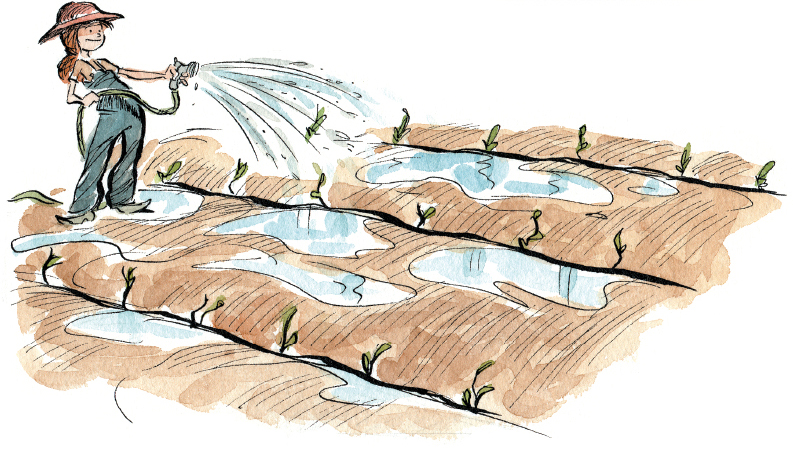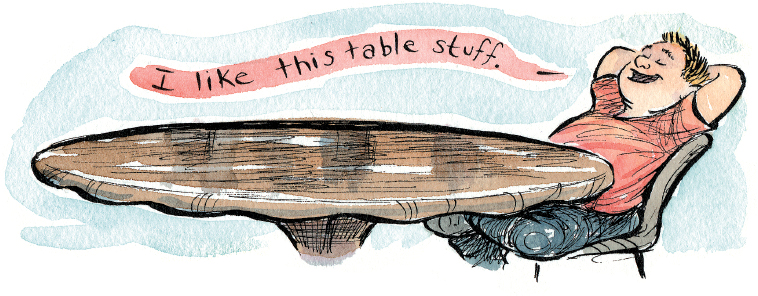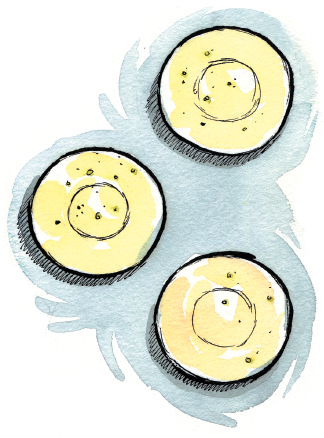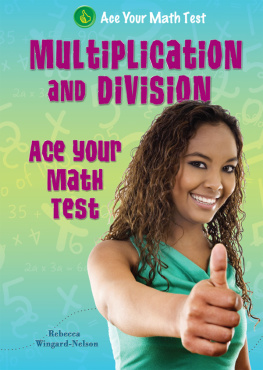GET READY, GET SET, MULTIPLY! Are you having trouble with multiplication? Are you confused by two-digit multiplication? Do you wish someone would explain the properties of multiplication? Well, ask no more! Rebecca Wingard-Nelson helps you tackle topics such as multiplying greater numbers, multiples of ten, regrouping, multiplication key words, rounding, and more!
FREE WORKSHEETS AVAILABLE AT ENSLOW.COM
About The Author Author
Rebecca Wingard-Nelson develops and writes math assessment tests, exit exams, proficiency tests, textbooks, and workbooks. She has written many math series for Enslow Publishers, Inc.


Math is all around, and an important part of anyones life. You use math when you are playing games, cooking food, spending money, telling time, reading music, or doing any other activity that uses numbers. Even finding a television channel uses math! Multiplication Is Everywhere You need multiplication in everyday life. It is used when you count things that are in groups or rows, when you need to know the area of a room or space, and when you need to know how much money it will cost to buy more than one of something.
Using This Book This book can be used to learn or review multiplication at your own speed. It can be used on your own or with a friend, tutor, or parent. Get ready to discover math... made easy!
Multiplication is repeated addition. Multiplication is just another way to repeatedly add a number.
You have five containers of tennis balls, and each container has four balls.
How many tennis balls do you have?

There are two ways to find the answer. You can find the total by adding the number of tennis balls in each container. 4 + 4 + 4 + 4 + 4 = 20 Or you can multiply. 4 added 5 times is 20. This can be written as 4 times 5 is 20, or 4 5 = 20.
Kaylee planted three rows of corn with six plants in each row.
How many plants did Kaylee have in all?
6 + 6 + 6 = 18 6 added 3 times is 18.
6 times 3 is 18.
6 3 = 18.

You can write multiplication problems in two ways, in a line or in a column.
line2 3 = 6column
The means multiply. The is sometimes read as times. The = means equals. The line in column multiplication also means equals.
When you read a multiplication problem out loud, you say 2 3 = 6 Two times three equals six, or Two multiplied by three equals six. The numbers being multiplied are called factors.  The answer to a multiplication problem is called the product.
The answer to a multiplication problem is called the product. 

Multiplication tables show mutiplication facts. This table shows the multiplication facts for the numbers 0 through 12. You can use a multiplication table when you do not remember a basic multiplication fact.

Lets look at
3 4. Find the first number, , in the top row.
Find the second number, , in the left column. Move down from the and across from the to the box where the row and column meet. This box has the answer. = 12 

The Zero Property0 number = 0
number 0 = 0 Multiplication with zero is easy! Zero times any number is always zero.

If you have three plates with zero green beans on each plate, you have zero green beans. 0 400 = 0

Any time you see zero in a multiplication problem, the answer is zero. 0 400 = 0

Any time you see zero in a multiplication problem, the answer is zero.
This is called the zero property. The zero property is true with every number. 1 0 = 0
1,789 0 = 0 0 5 = 0
0 327 = 0
Gwen is writing a story. She has six pages with zero words on each page. How many words has she written so far?
Multiply the number of pages by the number of words on each page.
The Property of One1 number = number
number 1 = number Any time you see the number 1 in a multiplication problem, the answer is the same as the other number.
The Property of One1 number = number
number 1 = number Any time you see the number 1 in a multiplication problem, the answer is the same as the other number.
This is called the property of one. One row of six stars is six stars.  1 6 = 6 Three groups of one fish are three fish.
1 6 = 6 Three groups of one fish are three fish.  3 1 = 3 The property of one is true with every number. 1 3 = 3 4,208 1 = 4,208
3 1 = 3 The property of one is true with every number. 1 3 = 3 4,208 1 = 4,208
Brents job is to wash the chalkboards in the classrooms of the elementary school every day. There are 16 classrooms, and each has one chalkboard.
How many chalkboards does Brent wash every day?
Multiply the number of classrooms by the number of chalkboards in each classroom. 16 classrooms 1 chalkboard in each 16 1 = 16 Brent washes 16 chalkboards every day.
factorA number that is multiplied with another number. Basic multiplication facts are sometimes divided into groups using one of the factors. For example, all of the basic facts that use the number 2 are called the TWOs facts. 2 1 = 2 Double 1 is 2 2 6 = 12 Double 6 is 12 When a number and any other number are multiplied, the answer is called a multiple. 2 1 = 2 Double 1 is 2 2 6 = 12 Double 6 is 12 When a number and any other number are multiplied, the answer is called a multiple.
The multiples of two are the numbers you get when you multiply any number and two. Use the TWOs facts to find five multiples of 2.



















 Math is all around, and an important part of anyones life. You use math when you are playing games, cooking food, spending money, telling time, reading music, or doing any other activity that uses numbers. Even finding a television channel uses math! Multiplication Is Everywhere You need multiplication in everyday life. It is used when you count things that are in groups or rows, when you need to know the area of a room or space, and when you need to know how much money it will cost to buy more than one of something.
Math is all around, and an important part of anyones life. You use math when you are playing games, cooking food, spending money, telling time, reading music, or doing any other activity that uses numbers. Even finding a television channel uses math! Multiplication Is Everywhere You need multiplication in everyday life. It is used when you count things that are in groups or rows, when you need to know the area of a room or space, and when you need to know how much money it will cost to buy more than one of something.  There are two ways to find the answer. You can find the total by adding the number of tennis balls in each container. 4 + 4 + 4 + 4 + 4 = 20 Or you can multiply. 4 added 5 times is 20. This can be written as 4 times 5 is 20, or 4 5 = 20.
There are two ways to find the answer. You can find the total by adding the number of tennis balls in each container. 4 + 4 + 4 + 4 + 4 = 20 Or you can multiply. 4 added 5 times is 20. This can be written as 4 times 5 is 20, or 4 5 = 20.  You can write multiplication problems in two ways, in a line or in a column. line2 3 = 6column
You can write multiplication problems in two ways, in a line or in a column. line2 3 = 6column The means multiply. The is sometimes read as times. The = means equals. The line in column multiplication also means equals.
The means multiply. The is sometimes read as times. The = means equals. The line in column multiplication also means equals.  The answer to a multiplication problem is called the product.
The answer to a multiplication problem is called the product. 

 Lets look at 3 4. Find the first number, , in the top row.
Lets look at 3 4. Find the first number, , in the top row. 

 If you have three plates with zero green beans on each plate, you have zero green beans. 0 400 = 0
If you have three plates with zero green beans on each plate, you have zero green beans. 0 400 = 0  Any time you see zero in a multiplication problem, the answer is zero. 0 400 = 0
Any time you see zero in a multiplication problem, the answer is zero. 0 400 = 0  1 6 = 6 Three groups of one fish are three fish.
1 6 = 6 Three groups of one fish are three fish.  3 1 = 3 The property of one is true with every number. 1 3 = 3 4,208 1 = 4,208
3 1 = 3 The property of one is true with every number. 1 3 = 3 4,208 1 = 4,208